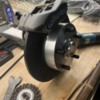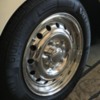I’ve been meaning to write this for a while. When I started down the madness trail I spent a lot of time on this site lurking and researching. I kept hearing some things repeatedly. One of those things was to really think about what you wanted before you jumped, and the other was that no component existed in a vacuum. Everything effects everything else. Taking into account how you planned to drive, what roads you liked, how much your partner was part of the experience, etcetera, were where you started. Lately I been reflecting on how much folks like Danny, Alan, Stan, Jimmy, Gordon, Michael, El Guapo, and the whole host of characters here had influenced how I went about making my choices.
It came back to me again when reading some recent discussions about engine character, dyno sheets, and horsepower and torque curves. As well as the ever recurring threads about transmissions; what gearing to get, and whether to go 4 or 5 speed, Subaru or VW. Some of our wiser folks talked about identifying the intended use, and thinking about that when putting together a cohesive package, with the emphasis on selecting engine and trans as a unit.
I thought it might be useful (or at least fun) to lay out my thinking when I selected what I did for my coupe. That being a Subaru 2.5 from OutFront with a Z head modification and stand alone engine management, a Rancho Pro-Suby transaxle with a 3.88 final drive and Quaife type limited slip dif, and Vintage 190 wheels w/tires at a roling diameter of 24.5”, and a Vintage Speed shifter.
Well, how did I get here? It started with a desire to have the coupe be as year round a vehicle for the Pacific Northwest as possible. That meant good heat and AC, and this was attained a little more easily with the Subaru. I also wanted to have electronic engine management and a less mechanically noisy engine in a coupe because my wife would come along for the ride a lot of the time. I wanted the car to be quick, fun on the back roads with a nod to GT use. There are great roads locally, and some truly great roads farther away requiring some highway travel. So in a nutshell, fast, all weather, reatianing GT use with a modicum of civility.
Here is some of the research into the Subaru engine. I didn’t know much about them, though I had a ton of VW AC experince and lots of motorcycle engine race experience, both 2 and 4 stroke. I was a SuperFlo certified CycleDyne operator at one point in life. So I looked up a dyno sheet for a stock EJ 253 2.5 SOHC Subaru and found the chart below with power, torque, and VE. This is as designed and at the crank, but some actual pulls I found bore it out.
Now this is an engineers smoothed curve for the engine as designed, but it served nicely for my purposes. One of the most important things to look at when evaluating these sheets is the shape of the curves and the area under the curve. The more area under the curve, the better. The flatter the curve the less racy the engine feels, but the more forgiving it is to drive. As much as I liked riding my 125cc two stroke GP bike, keeping it on the boil was very demanding. Its power curve looked like a witch’s hat with 5 hp below 9,000 RPM, 41 hp at 11,500, 20 hp at 13,000 and rings scattered all over the crankcase at 14,500. Fun, engaging, but not streetable.
Anyway, I wanted to make a few modifications using my experience modifying 4 stroke race bike engines. I had found that freeing up the breathing and raising the compression ratio, while keeping the stock cam profiles, typically resulted in a very flexible engine that was easy to ride quickly due to a broad torque curve, a progressive power curve, and plenty of area beneath both. It would esentially take the same shape curves as stock and add area underneath. With the right power to weight ratio this type of motor could head for redline quickly, too.
I taked to John at OutFront Motorsprts and that approach was just what he had in mind with his Z-head conversion. It does exactly what I wanted, and he’s mapped a whole bunch of them, so the EFI and ignition curves should be spot on. These changes should keep the dyno curves shown above essentially the same shape, but move them nearer the top of the page for more area underneath. I’m over simplifying a bit here, intake and exhaust will influence the smoothness of those curves for instance, but you get the drift. I’ll also inject a bit of reality here: I don’t really think it’ll be a 200 hp motor, more likely an optomistic 185 at the crank, but that’ll be plenty for this chasis. John originally came up with this combo for sandrail use where bags of torque, good power, and a nice overun are really useful.
So now we have an engine with a torque curve that peaks smoothly from 3500 - 5500, and one should be within 10% of peak torque from 2300 to 5800 RPM, and within 20% of peak from 1,500 to 6500 RPM. The HP curve is very progressive and gets serious at about 3500 RPM and peaks at 6000 rpm. Red line is at 7000 and power falls off very progressively. It looks like an engine that should usable and entertaining.
So we’ve got the engine sorted and we have a pretty good idea what it’s character will be like. Now onto the transmission where we explore a few things. First off is the 4 speed vs 5 speed or even 6 speed debate. There’s a general feeling that more is better and that having more ratios, and shifting more to take advantage of them, will be faster. To which I say, “Maybe.” Going back to that RS 125 it had 6 speeds and 8 would have been really nice, because that engine had no flexibility. The engine we have here is very flexible and so it doesn’t really require a lot of gears.
Shifting a lot doesn’t necessarily make things faster (it sounds faster, but…). I’m going to take a moment here and share a story to illustrate that point. Back in my motorcycling days I was an instructor/control rider for track days. We’d put new guys out on the track follow the leader style to teach them the line and let them get a feeling for it while keeping speeds low. Then we’d pull them in and talk about being smooth and hitting their marks. We ask them to go back out and ride the track as best they can concentrating mainly on their corner entry speeds, BUT they can’t use the brakes and they must stay in 3rd gear. No shifting, no braking!
After that session and another break with a talk they’re sent back out and allowed to shift and brake as much as they want. Then we break for lunch. We’ve had timing transponders on the bikes the whole time and at lunch we take a look together. Guess what, almost all the fastest times were set without shifting and braking. Most of these guys were pretty sure they knew exactly what they were doing, but at real speed shifting takes attention and time, while threshhold braking is a mighty skill to master. Obviously with instruction, practice and dedication they could improve those skills and they would (and did) get faster, but there’s a reason CRTs are baned in Fomula 1 (and it’s not just time saved by shifting, of course).
Back in our world I had an engine that didn’t require alot of gearing in a lighter car. So personal preferences took precedent. I knew that what I wanted a very mechanical experience, analog as they say. I like the feel of a well set up Porsche or VW transaxle. Take out the slop and set it up right. I even like the gear noise. Some cable shifters are great, but they still feel ‘cable-y’ to me (I'll admit that some of them are quite good indeed). I didn’t want to go that route. Research again, and talking to Greg suggested a call to Rancho to look at their Pro-Suby transaxle. I talked with the guys there, got the ratios and then went to work seeing what that would look like with the engine I had cooking.
Here is a transmission graph with the actual ratios, final drive, and wheel diameter entered shown side by side with the dyno sheet. It looked like this transaxle would work great with this engine. Fast backroad work would be a mostly 2nd and 3rd gear thing. A 6,000 RPM shift from 2nd to third would happen at 58 mph and drop the RPMs to 3800 right near the enginge’s torque peak. That next wave could be ridden to 6,000 RPM in third all the way to 95 MPH. Conversely 3rd could be taken down to 30 MPH and it would still be within 10% of peak torque. Given the weight of the car I think that’ll do nicely. I called Rancho back and decided to add the Quaife type differential to keep it hooked up in the rain (it does rain here sometimes).

The last piece of all this is the shifter and again research here confirmed that a Vintage Speed shifter was the way to go. I made my own laminated wood shift knob, too, because all the places you touch the car are important and it makes me smile.
And there you have how I settled on a drive train. I’m sure I made some mistakes, but I’m OK with that because I made the effort to really think it through. Besides, I wouldn’t be where I am now if I hadn’t made all the mistakes I’ve made thus far. I hope this proves usefull to someone.






























